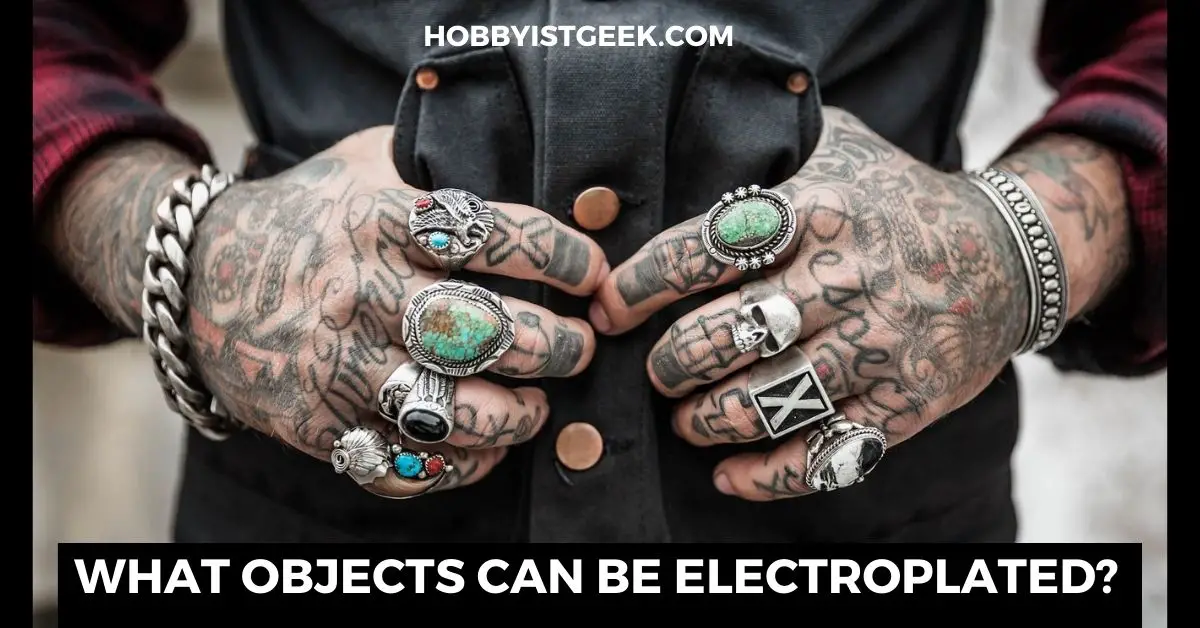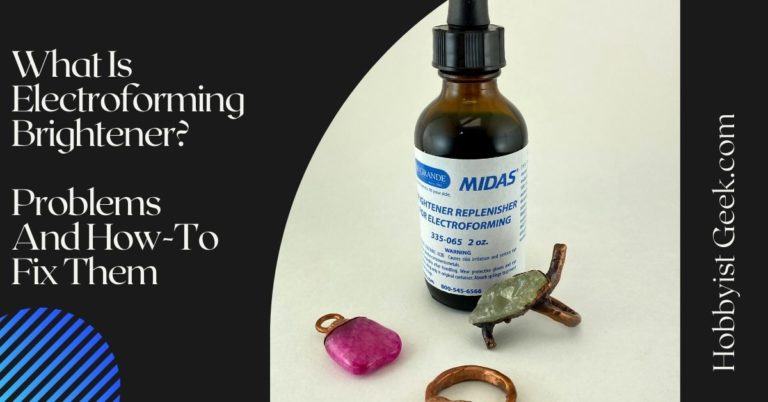What Objects Can Be Electroplated?
Introduction:
What objects can be electroplated? This is the next topic I will be covering as I continue my learning journey into my new hobby of electroforming.
While alchemy – the magical transformation of common chemical elements into rare and valuable ones – does not exist, electroplating might be the next best thing.
The idea is to cover a relatively common metal, such as copper, with a thin layer of more valuable metal, such as silver or gold, with the help of electricity.
The answer to What objects can be electroplated?
Every piece of jewelry can be directly electroplated, from zinc to gold, copper, silver, tin, zinc, and many more.
Plastic can also be electroplated; however, since it is not a conductor, it can’t be electroplated directly, and the process involves a lot of indirect steps.
Aside from making less expensive metals look expensive, electroplating has several other applications.
It can be used to make rust-resistant materials and several valuable alloys such as brass and bronze and even make plastic look like metal.
What is the mechanism behind this incredible process?
Let’s take a look at it more closely!
What Is Electroplating?
As we find out what objects can be electroplated we must determine what is electroplating?
Electroplating is a chemical process of plating one metal onto another by hydrolysis, mainly to prevent metal from corrosion and for various decorative purposes.
It has been used for decades to coat various metals with others by jewelers, scientists, and people who have the hobby of metal craft and do it at home to create decorative pieces of metals.
What Is The Difference Between Electroforming And Electroplating?
These two processes are often confused with being one, and it can’t be more wrong.
Sure, the heading already gave you an idea that both are different processes, but this misunderstanding needs to be discussed in detail.
Even though both processes are done utilizing electrodeposition, the main difference between the two is that, while in electroplating, the deposited metal becomes part of the existing metal product by plating or coating on it, while in electroforming, the metal is built up in layers.
After the process is completed, the metal object that remains is entirely created through electrodeposition.
After electroforming, it is also possible to perform electroplating on the product to add a coating to make the product more corrosion-resistance and give it a more decorative look.
What Is The Detailed Description Of Electroplating?
The whole process of electroplating involves many steps, namely:
Cleaning The Piece To Be Electroplated
The first step of electroplating is to clean the metal that you want to electroplate as any contamination on the surface of the subject metal will prevent the electroplating coating from properly adhering to the surface of the metal.
Generally, an alkaline detergent is used for this purpose.
The metal is soaked in it for a bath for 5 to 10 minutes, and 150 F temperature is usually enough to rid most of the surface of dirt and soil.
Activation Of The Subject Metal
To finish the preparation of the subject metal, it is passed through the process of activation.
It involves submerging the metal into acidic solution to remove various oxides and scales, which are generally formed on the metal surface during manufacturing, handling, and storage.
Preparation Of The Plating Solution
The electroplating process then requires an electrolyte solution of the metal that you are electroplating onto the core piece for the subject metal to be immersed into.
This plating bath consists of a metal ion solution and various other chemicals to assist in the electroplating process.
Plating
After all the initial steps are completed, we can finally move to the plating process.
While at the industrial level, rack plating is used, we are discussing electroplating as a hobby at home, and we would consider a smaller plating tank.
In the solution tank of the metal that you are electroplating onto the core piece, direct current is applied to the metal that you are electroplating on your core piece for a given time, which results in the metal ions depositing onto the cathode where we have the subject metal.
The flow of electricity has to be uniform for uniform electroplating.
Rinsing And Drying
After the electroplating is completed, the newly plated metal piece must be rinsed well with water and then dried.
If there is extra contamination, metal should be rinsed multiple times for a cleaner surface.
If additional protection is required on the electroplated shell, sealers and passivates can be applied after the rinsing.
What Materials Will I Need To Electroplate?
As discussed earlier, electroplating is done to either protect the metal or give it a more decorative look.
Industrial metals are electroplated for longer life, and metals like copper are electroplated with expensive metals like silver and gold to provide them with a more luxurious look. Such electroplated metals are then used as Jewelry.
Please post this Pinterest pin to your Pinterest Boards.

What Are Some Examples Of Electroplating?
There are multiple daily-life examples of what objects can be electroplated such as electroplating.
Kitchenware, Jewelry, and coins are some everyday examples of electroplating.
They are plated for extra-protection and decorative purposes, or both.
At a non-commercial level, many people electroplate various metals as a hobby, and you must have seen some electroplated metal objects at the home of friends with an interest in electroplating.
People with this interest often electroplate little metallic pieces and small sculptures, and other things of interest.
Which Metal Is Used For Electroplating?
Some of the most commonly used metals for electroplating are copper and zinc.
It is since while copper is highly conductive and heat-resistant, zinc has no substitute when it comes to corrosion resistance.
Nickel is another highly corrosion-resistance metal, but it is an expensive option compared to zinc.
So, depending upon your reason behind electroplating, you will either use copper or zinc.
If you are looking for a decorative electroplating product, silver or gold will be a better option, while for protection purposes of your electroplated piece of metal, zinc should be preferred.
Can You Electroplate Steel?
Steel is a highly corrosive metal, and if there is a metal that needs to be electroplated more than others, it is steel.
Since steel is a conductor, to answer your question, yes, it can be electroplated.
Since there are many types of steel, carbon steel is the one that is most vulnerable to corrosion damage.
Steel plating is similar to plating on other metals.
If you’re electroplating steel, you’ll have to clean it first and then place it in an electrolytic solution with the plating material and electricity.
Can Plastic Be Electroplated?
Since plastic is not a conductor, direct electroplating cannot be performed on plastic.
However, plastic can be electroplated indirectly through a series of steps.
Plastic electroplating is carried out in various stages, starting with applying conductive paint to the surface of plastic before going for the rest of the simple electroplating process.
Electroplating plastic is usually done to make plastic pieces gleam and to give plastic a new look.
In short, the process of plastic plating revolves around changing the plastic surface to a metal (copper, preferably) and then plating it with gold, silver, or nickel.
Plating plastic will also increase its wear resistance and strength.
What Are The Advantages Of Electroplating?
Electroplating has been used for centuries for various advantages that it offers for metals, including:
Corrosion Resistance
Corrosion-prone metals such as steel and iron can be coated with a layer of many non-corrosive materials, thereby protecting the original metal.
This is the primary purpose of electroplating, and probably eighty percent of worldwide electroplating is done for this purpose.
Decoration
With the help of electroplating, lustier and shine can be applied to otherwise very dull metallic surfaces.
It helps in making many metallic decorative items.
Less Expensive Jewelry And Art Pieces
Instead of making expensive and rare ornaments out of silver and gold, similar and cheaper ornaments can be made with electroplating.
This reduces the cost of plated the pieces significantly and makes them affordable.
Improving Mechanical Characteristics
Electroplating can also significantly improve the mechanical characteristics of metals, such as flexibility and tensile strength.
What Are The Disadvantages Of Electroplating?
With all the benefits that electroplating has to offer, some disadvantages come with electroplating.
Some of these disadvantages are:
Non-Uniformity
If not done perfectly, electroplating may not be uniform, which often results in a very substandard appearance of the metal that has been plated.
Years of experience and a robust skill set are required to master the art of electroplating.
Cost
If you are already into electroforming and have a power supply, electroplating will not be expensive.
If you have to buy everything new, the cost is still reasonable.
However, gold and silver plating could be a little expensive as they are expensive metals.
Pollution
After use, the electroplating solution needs to be disposed of safely, and it is a critical environmental concern.
Can I Electroplate At Home?
Yes, you can, and it is a straightforward process. You can find people who are doing plating at home for years and have developed it as their hobby.
To do it at home, follow these steps:
Clean And Polish The Metal:
Before proceeding to electroplate with the desired metal, clean your jewelry piece i.e., electroformed copper pendant thoroughly, as even the slightest spot of dirt or grease will prevent the plating deposit from adhering.
Once cleaning is done, polish the given pieces and rub them over with a cloth piece and fine pumice powder to roughen the metallic surface slightly.
After then, dip the piece of metal in an acidic solution to give it a final clean look, ready to be electroplated.
Making Nickel Plating Solution:
It is an easy way to buy nickel salts online, but where is the fun in that? As a hobbyist, this is the way I prepare my nickel-plating solution.
First, fill your mason jar with distilled vinegar leaving about half an inch from the top.
Dissolve a pinch or so of salt into the distilled vinegar.
The purpose of adding salt is to increase the electrical conductivity of the vinegar solution.
The more current that flows through the vinegar, the faster we can dissolve the nickel in it.
Connect an alligator lead from the positive terminal of your power supply to one of the nickel electrodes. Do the same from the negative terminal to the other electrode.
It is important to ensure that the alligator clips don’t touch the vinegar or they will contaminate the final product.
The nickel source connected to the negative lead of the power supply should start to create some hydrogen bubbles and the positive lead should start making oxygen bubbles.
Truth be told, a very minute amount of chlorine gas (from the added salt) will also be formed on the positive lead, but unless you have put a lot of salt, the chlorine will just dissolve into the water like as in a swimming pool.
The little amounts of sodium, in case you are wondering, will react with the solution water to create sodium hydroxide.
DC power supplies should be preferred over less efficient batteries that are sometimes used for this purpose.
Dissolving the nickel-metal will take a while and you shouldn’t use the less efficient battery option as DC power supplies are reusable.
After a little while (mine took about an hour or two), you can notice the solution has turned light green. This is your needed nickel acetate solution.
If you get yellows, blues, or reds, or any other color, your nickel wasn’t pure.
The end product should always be clear green and if it is cloudy, you must have an impure nickel source.
Electroplating:
Subject metal is then dipped in the nickel electrolyte as a cathode, while the metal that is being used for electroplating the metal is used as the anode.
Electroplating time may vary depending upon the nature of the metals.
At home, a smaller solution tank is used for electroplating since it is a relatively more straightforward option, and metal can be evenly covered.
Cleaning And Drying:
Once the metal’s electroplating is done, the resultant metal piece is cleaned and dried to give it a final look.
Final Thoughts For What Objects Can Be Electroplated?
I have always been fond of learning new ways to do things including electroforming and electroplating in my art creations.
I found electroplating to be very useful for making pieces of metal look enticing by coating them with gold and silver.
It is also much cheaper and easier to set up your little electroplating rig than you might imagine.
In this guide to electroplating, most of what I have discussed about electroplating comes from my personal experience of plating various metals as it is my hobby.
As with the majority of other technologies, metal electroplating is perpetually improving and evolving.
The new and futuristic electroplating technologies promise to grow and enhance the way hobbyists use this process in the coming years, and with the evolution in the industry, new techniques are coming for the DIY plating process.
I hope you learned all about what objects can be electroplated.
Electroforming: The Ultimate Guide Check It Out!
Resources:
https://www.instructables.com/Clean-and-Simple-Electroplating/
https://www.youtube.com/watch?v=O3DCexCLoGQ https://www.youtube.com/watch?v=SIU3lsZMx7A
- Electroforming Conductive Paint, Where To Buy It, And How To Make It – The Ultimate Guide - April 24, 2021
- Copper Electroforming Solution Recipe - April 20, 2021
- Can You Electroform Polymer Clay? - April 13, 2021







